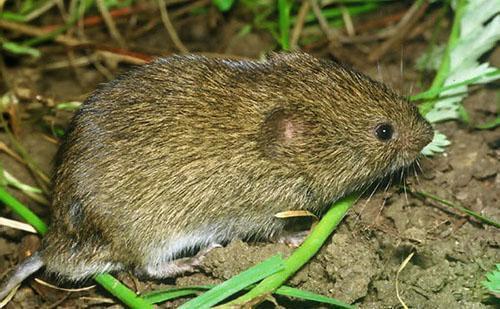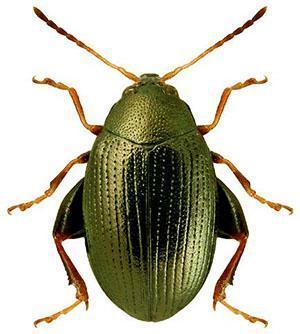Beet pests and control
 Caring for garden crops includes pest control measures. In cramped conditions, even crop rotation does not save. So, pests of cruciferous plants simultaneously harm haze. Insects that have developed on fruit bushes colonize beet leaves, if processing is not carried out in time. Knowing beet pests and measures to combat them is necessary for every gardener.
Caring for garden crops includes pest control measures. In cramped conditions, even crop rotation does not save. So, pests of cruciferous plants simultaneously harm haze. Insects that have developed on fruit bushes colonize beet leaves, if processing is not carried out in time. Knowing beet pests and measures to combat them is necessary for every gardener.
Preventive actions

If vole mice live on the site, then the question of who gnaws beets in the garden is unambiguously resolved. You need to get a kitty, and the mice will go away.
In addition, there are enough hunters to feast on young sweet tops and roots. But if in the fall the site has been cleared of plant debris, there are no reserves that mice could eat in winter, then there is more guarantee that the rodents have not settled in. Reducing the number of other pests in the ground can be:
- deep digging of the soil in autumn and spring;
- laid out traps and baits for bear and wireworm;
- sprinkling the holes and seedlings of beets with ash, tobacco dust, deterrent preparations;
- keeping the beet bed clean from weeds and in the moist state of the surface soil layer.
Digging the soil destroys the paths of pests. The wireworm is collected at the same time. It is especially good to carry out digging in the fall before freezing in order to destroy pests in the upper fertile layer.
Ash is a fertilizer for beets at all stages of their growth, but it will not allow beet flea and slugs on the garden bed. Weeds are breeding grounds for the primary development of insects, which then move to cultivated plants.
Beet pests and control
 In order to fight you need to know the enemy by sight. Of the many insects and diseases, the most harmful and common ones can be distinguished. Photos of the disease and pest of beets will help determine the disease.
In order to fight you need to know the enemy by sight. Of the many insects and diseases, the most harmful and common ones can be distinguished. Photos of the disease and pest of beets will help determine the disease.
Beetles
From the very beginning of the development of young plants, adult beetles do harm, which eat up the leaves and the growth point. The beetle is dark green, with a pearlescent sheen. It is small, about two millimeters, and its larvae are just as small. You can fight it with ash powder and Inta-vira.
Medvedka
 A dangerous pest is a bear or a crayfish. This beetle is 50 mm long. He lives in the ground, hibernates in deep non-freezing layers. Medvedka makes nests and lays eggs. The larvae do no less harm by gnawing the roots of plants. The fact that this pest appeared in the garden can be judged by the path of dead plants and burrows in the ground.
A dangerous pest is a bear or a crayfish. This beetle is 50 mm long. He lives in the ground, hibernates in deep non-freezing layers. Medvedka makes nests and lays eggs. The larvae do no less harm by gnawing the roots of plants. The fact that this pest appeared in the garden can be judged by the path of dead plants and burrows in the ground.
Nematode
 Another secretive pest is the nematode, a worm that lives in the ground and does great harm by eating roots and laying cysts on roots. When the nematode settles, the plant lags behind in growth and dies. You can fight this pest with the help of autumn sowing of siderates - mustard, rapeseed. At the same time, the nematodes crawl to the plants, which are then mowed and plowed deeply.This is how most of the pest is destroyed.
Another secretive pest is the nematode, a worm that lives in the ground and does great harm by eating roots and laying cysts on roots. When the nematode settles, the plant lags behind in growth and dies. You can fight this pest with the help of autumn sowing of siderates - mustard, rapeseed. At the same time, the nematodes crawl to the plants, which are then mowed and plowed deeply.This is how most of the pest is destroyed.
Beet fly
 One of the most common pests. If the beet leaves dry up, you need to carefully look at the inside, the larvae are transparent and similar to caterpillars. You can get rid of the pest by picking the leaves with pests, and treating the planting with an insecticide. The earth needs to be loosened and spilled with an ash solution. The fly lives on weeds and moves to cultivated plants.
One of the most common pests. If the beet leaves dry up, you need to carefully look at the inside, the larvae are transparent and similar to caterpillars. You can get rid of the pest by picking the leaves with pests, and treating the planting with an insecticide. The earth needs to be loosened and spilled with an ash solution. The fly lives on weeds and moves to cultivated plants.
Beet bug
 The insect causes considerable harm to plants. A small bug, only 3-5 mm in size, eats five times its weight per day. It multiplies rapidly and the leaves infected with the bug acquire blistering. If you do not fight the pest, the plant will die. And again, the root cause of the spread of the insect is weedon which he gets divorced.
The insect causes considerable harm to plants. A small bug, only 3-5 mm in size, eats five times its weight per day. It multiplies rapidly and the leaves infected with the bug acquire blistering. If you do not fight the pest, the plant will die. And again, the root cause of the spread of the insect is weedon which he gets divorced.
Miner mole
 A small brown butterfly fluttering among the plants does not cause fear among summer residents. But this is a malicious pest, a mining moth. She makes a clutch of eggs on cuttings of beet leaves, and young caterpillars penetrate deep into the fruit and gnaw holes in it. This pest damages all types of beets. She dies. If a mining moth appears, then after harvesting, you need to remove the tops and treat the land with an insecticide.
A small brown butterfly fluttering among the plants does not cause fear among summer residents. But this is a malicious pest, a mining moth. She makes a clutch of eggs on cuttings of beet leaves, and young caterpillars penetrate deep into the fruit and gnaw holes in it. This pest damages all types of beets. She dies. If a mining moth appears, then after harvesting, you need to remove the tops and treat the land with an insecticide.
Phomosis and cercosporosis of root crops
 Beet diseases are of infectious and physiological origin. Physiological changes include changes in the plant due to a lack of nutrients or their imbalance. Such a disease can be the phomosis of roots and leaves with a lack of boron in the soil. From this, the hollowness of root crops is formed.
Beet diseases are of infectious and physiological origin. Physiological changes include changes in the plant due to a lack of nutrients or their imbalance. Such a disease can be the phomosis of roots and leaves with a lack of boron in the soil. From this, the hollowness of root crops is formed.
The first signs of phomosis will be a change in the leaf blade. It represents lightened spots with dark dots in the middle.
 Cercosporosis of beet leaves begins to develop at high humidity or prolonged rains.
Cercosporosis of beet leaves begins to develop at high humidity or prolonged rains.
In addition, beets are affected by various rot, powdery mildew and beet root. All of them arise from improper plant care.